Collecting a Western redcedar for bonsai
On a whim, I attended a bonsai show in Sacramento last month (click here to read my post). The exotic-looking miniature trees really struck a chord in me, and I started to read up on bonsai. I’m still at the very beginning of what might end up being a life-long journey and I feel I need to learn a lot more before I even attempt to work on a living plant. However, when we were at my in-laws for Thanksgiving, I couldn’t help but notice the thousands (literally!) of saplings growing everywhere on their 2½ acre property. There is white pine (Pinus monticola) and Ponderosa pine (Pinus ponderosa), but above all there is Western redcedar (Thuja plicata).
As its Latin name already indicates, Western redcedar isn’t a true cedar (like Lebanon, Atlas, or Deodar) but rather an arborvitae. That’s why “redcedar” is spelled as one word rather than as two, as would be the case if it were a true cedar.
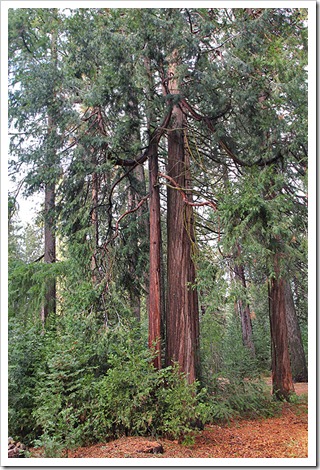 |
| A few of the many mature Western redcedars on my in-laws’ property |
While Western redcedar doesn’t seem to be used much as bonsai material, there are so many of them at my in-laws’ that I decided to collect two of them to experiment on down the line. (A close relative, eastern whitecedar, Thuja occidentalis, is a popular tree for bonsai on the East Coast and in Canada. If you’re curious to see what it can look like as a bonsai, go to the website of the Toronto Bonsai Society, click the Galleries button on the top and then click Cedar on the left.)
Picking likely candidates was actually the hardest part. One of the most important criteria for a bonsai is a strong, interesting trunk. I bypassed many saplings because their trunks were too spindly or ordinary and finally settled on two that had a relatively thick trunk relative to their size, with peeling bark and some scars to give them character.
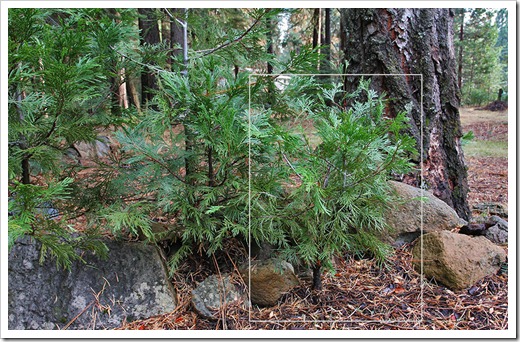 |
| My first candidate, about 2 ft. tall with a trunk diameter of ½" at the base. I removed some of the rocks for better access. |
As with any plants you did up in the wild, the goal is to remove a generously sized root ball that has as many fine feeder roots as possible. At least that is the theory. On my first sapling I ended up with hardly any feeder roots; I think they broke off as I rocked the tree out of the ground with the shovel. I was disappointed and felt guilty for potentially having killed a tree. I don’t know what its odds for survival are but it went into a bucket which I filled with native soil.
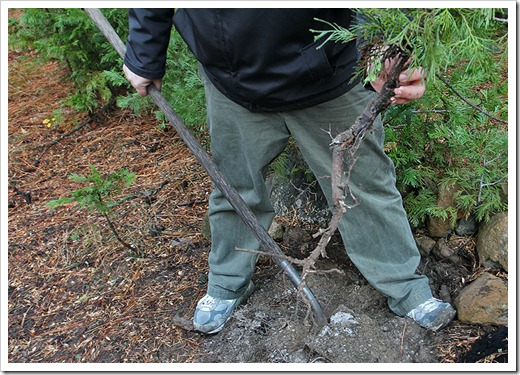 |
| Did I just kill this sapling? |
| I asked my mother-in-law to take a few photos of me digging. She ended up taking more than 70 so I combined them into a little movie. |
For my second tree, I picked a sapling that had good clearance on all sides, and I was more careful as I dug around it.
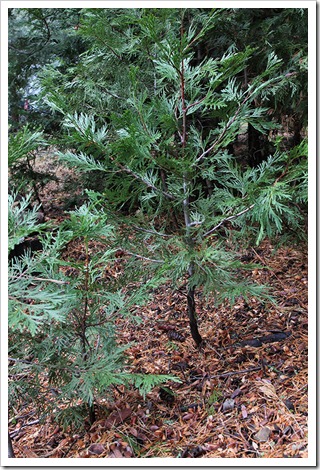 |
| My second candidate, 3 ft. tall with a trunk diameter of 1" at the base. |
In spite of recent rains, the soil below the top inch or two was completely dry and it fell off as I lifted the root ball out. While there aren’t as many roots as I had hoped for, it looks like there are enough for the tree to survive. Knock on wood!
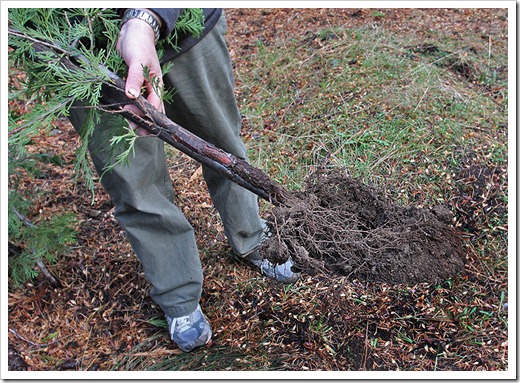 |
| I was able to preserve what I hope are enough roots for the tree to survive |
The next time I attempt to dig up a tree at my in-laws’, especially a taller one with a thicker trunk, I’ll ask my father-in-law to fire up his backhoe. That should make it much easier to preserve as many roots as possible.
The next step now is to pamper these young trees until they show sign of new growth. Then I can begin to train them for bonsai. By then I will hopefully have taken a workshop and acquired more knowledge and skills.


Nice initiative! I'm wondering if those are a bit too large for bonsai specimens already though? (I don't have any experience with bonsai.)
ReplyDeleteAlan, I would have thought that, too, but when bonsai aficionados collect trees in the wild, they often take surprisingly large specimens that have the desired trunk diameter. I just came across this long but very interesting article yesterday.
ReplyDeleteYea with bonsai you actually collect a much larger tree than you want and you start working it down to be small. If you go the other route (start with a small, young tree and help it grow into a bonsa) you are looking at 20+ years of work. That is because in order to get the desired "small tree that looks old" design, you need a nice ratio of trunk width to trunk height. (VERY generally speaking width is 1/3 the height). Since young trees have very thin trunks for a long time, you are best getting a bigger tree and working it to be shorter by cutting it down over time. The best collectable species have branches coming off the trunk as low to the ground as possible because ultimately you realize you are going to cut off most of the upper 2/3 of a larger collected tree. If there are no branches down low you are then left to HOPE that cutting the tree back will result in new branches growing off the trunk where you want them. This is why bonsai collectors dont just grab any random tree they like the overall look of. They look specifically for ones with nice wide trunks, a good taper (the trunk is wide at the soil surface than at the top), lots of branches to choose from, and lots of roots.
DeleteThe one you collected does not have many branches near the bottom and to get a good bonsai you will want to style it down to about 12" tall. That said, its not unusable by any means. There are LOTS of different styles and this one could be a "literati" style where the tree is tall, thin, and has small 'tufts" of foliage. You will need to encourage back budding (new growth on old wood) which, depending on the species, can be more difficult (tip: conifers are typically more difficult to do this with unless a landscape cultivar that is made for that).
I actually might have gone for the smaller one to the left of your second candidate. That one would actually fatten up to the diameter of the desired one in about a year however since you will be able to control it's grow during that period, you can force it to maintain the lower branches and push the growth where you want it. It is also more pliable so you can bend it!
Either way, enjoy the tree!!!!!
and yes, i realize this is an OLD post. I am curious to know if you still have the tree and still are into bonsai!
DeleteThank you SO MUCH for the information you posted. I really appreciate it.
DeleteMy tree died; I don't think it had enough roots.
I'm still into bonsai, but only theoretically. In other words, I've never actually gotten around to giving it a hands-on try. Life is just too busy. But my interest is still there. At least that's something :-).
Very interesting! I would have thought the same as Alan but I don't know anything about bonzai. Good luck and let us know how it goes!
ReplyDelete